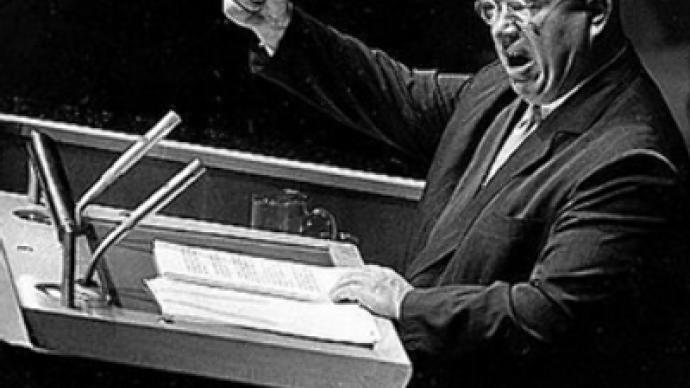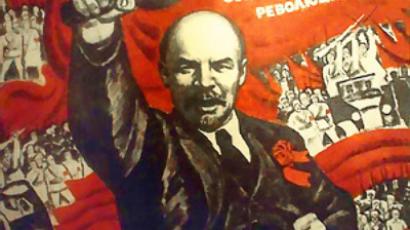World’s 10 most ambiguous political myths

George Washington is considered to be the very first president of the United States, but was he? Here they are: the top political myths, from the signing of the Magna Carta to President John F. Kennedy’s assassination.
Khrushchev and his shoe
On October 13, 1960, an angry Nikita Khrushchev reportedly took off his shoe and used it to pound the podium while scolding a delegation from the Philippines during a meeting of the United Nations General Assembly. The bold move came as a response to an accusation that the Soviet Union was oppressing the majority of Eastern Europe.
The story was first conveyed by the New York Times in a report from Benjamin Welles, but ever since the report was published there have been many conflicting accounts of what really happened. By many accounts, Khrushchev did have a shoe in hand, but the question remains how exactly it was used. Welles stated in his report that Khrushchev "pulled off his right shoe," but there are witnesses who say that his size alone prevented him from leaning over to do so in the constricted environment in which he was standing. In another account, the Soviet leader actually lost his footwear while trying to escape questions from the press. Thus, the shoe was returned to him discreetly immediately prior to his speech, explaining why he may have had a shoe in hand.
Though there is little debate about whether Khrushchev was passionate and animated in his actions, there is surprisingly little photographic or video evidence to support the shoe-banging incident, despite the number of cameras documenting the event. The shoe may never have collided with the podium after all, but whatever action Khrushchev took on that day created an iconic image that will continue to live on.
George Washington and the cherry tree
Ask any boy or girl in the United States and they will be able to tell you the story of George Washington and the cherry tree. As the story goes, a young Washington was anxious to try out his new hatchet and he did so by chopping down a cherry tree. When confronted by his father, the boy answered, "I can't tell a lie, Pa; you know I can't tell a lie. I did cut it with my hatchet." It is a great tale of honesty and integrity, both very good characteristics the people of a nation would like to attribute to their leader – but is it true?
Mason Locke Weems is the man responsible for the cherry tree legend, a story printed in the first-ever biography of George Washington, “Life of George Washington: With Curious Anecdotes, Equally Honorable to Himself, and Exemplary to His Young Countrymen.” The book was published in 1800 and was released in many subsequent editions for the next 150 years. However, having been written in the year following the famous president's death, there was really no way to refute some of the anecdotes Weems claimed as fact. Though it is a wonderful tale to help teach schoolchildren about morals, it is generally believed that Weems himself was not nearly as honest as the main character in his story.
Did Churchill really say that?
Aside from his duties as England's prime minister, Sir Winston Churchill also made his mark on history as one of the world’s greatest orators. It is undeniable that Churchill's use of language and manner of speech were a strong inspirational factor to the people of Great Britain during the tough times of World War II. While his public speeches are among some of the most memorable in history, Churchill was also known for his quick wit and sense of humor. While most of his speeches have been transcribed, some of the more famous quotations come from the acidic exchanges and quips between Churchill and Lady Nancy Astor.
One of the better known lines comes from Astor commenting on the prime minister's appearance of being drunk, to which Churchill replied, “And you, Madam, are ugly. In the morning I will be sober, but you will still be ugly." As these exchanges were between two individual people, it is hard to prove that they actually occurred, but they do serve as an illustration of the relationship between the two politicians and many examples similar to this one endure.
One well-known quotation that is certainly misattributed to Churchill reads as follows, "If you're not a liberal when you're 25, you have no heart. If you're not a conservative by the time you're 35, you have no brain." Though the origin is unknown, The Churchill Centre and Museum at the Cabinet War Room in London suggests that Churchill's actual political beliefs were exactly opposite to the sentiment of the statement.
Anna Anderson or Anastasia Romanova?
On the morning of July 17, 1918 the Red Guard rushed into Ekaterinburg on Lenin's orders to kill Nicholas II and the entire Romanov family. The murder was successful, but there were consistent rumors and hopes that two of the children, Aleksey and Anastasia, had somehow escaped and survived. Through the years the rumors became legend and many women have stepped forward to claim to be the Grand Duchess, but none have been able to prove their case.
The most famous instance is of Anna Anderson, an orphan found in Berlin. Anderson kept quiet about her past, but eventually claimed that she was indeed Anastasia, eventually convincing Romanov friends and relatives, including Grand Duchess Olga Aleksandrovna, Anastasia's godmother. More credibility was given to the Anastasia survival mystery after a grave was found in Ekaterinburg, containing the remains of the Romanov family, but with two children conspicuously absent.
Alas, in 2007 the mystery could finally be put to rest as a new grave was found just a short distance from the first. DNA evidence proved that the occupants were the two children believed to have escaped so many years ago. Even with strong and compelling evidence of Anastasia's unfortunate end, there are still occasional claims that she survives to this day.
Rasputin
The self-proclaimed mystic and healer known throughout Russia as "The Mad Monk," Rasputin may indeed have a sinister and cloudy reputation that is still unsurpassed. Born in Siberia, Grigory Efimovich Rasputin was legendary for his lascivious ways and passion for opium, but many believed that he also carried amazing powers. Lending to the rumors of his fantastic abilities perhaps was an incident in which Rasputin reportedly healed Tsarevich Aleksey Romanov from dying of hemophilia. This incident cemented a relationship between Rasputin and the Romanov family, creating speculation throughout Russia's elite that he may have had an uncanny level of influence over state affairs.
Probably the most famous story regarding Rasputin comes from the tale of his murder, which he is said to have predicted. Fearing Rasputin had become too powerful, the Tsar's cousin, Prince Feliks Yusupov, and a group of conspirators invited the mystic to the prince's home in St. Petersburg. There he was served both cakes and wine laced with enough poison to kill five men, but to no effect. Surprised by his survival, the group repeatedly shot Rasputin, but even so the mystic reportedly rose up to grab Yusupov in a stranglehold. The group proceeded to beat Rasputin until they were sure of his demise, but taking no chances they tied up his body and dumped it into the river.
Autopsy reports indicate that the controversial figure actually died from drowning, suggesting he had lived beyond the massive trauma inflicted on him earlier. Scientific reports and current forensics argue that some of the accounts were greatly exaggerated and have been able to explain much of the mystery away. Still, the legacy of Rasputin endures.
Is John F. Kennedy really a jelly doughnut?
"Ich bin ein Berliner" is the famous phrase that President John F. Kennedy delivered to a crowd in West Berlin in 1963. The intended meaning of the phrase? "I am a citizen of Berlin!" It was an attempt by the popular American president to relate to his audience and to show solidarity between the people of the United States and a Germany divided by the Cold War. Unfortunately, good intentions can sometimes go awry, as almost instantly reports spread throughout the globe that the president had gotten it wrong actually saying, "I am a jelly doughnut!"
The controversy comes from the fact that there is a jelly doughnut-like pastry in Germany called “Berliner Pfannkuchen.” It is also called a Berliner for short. When referring to their origin, natives simply say, "Ich bin Berliner," dropping the article "ein" altogether. Though technically Kennedy could have been interpreted to claim his status as a jam-filled pastry, scholars say that his usage of the German language was absolutely correct for his intended meaning.
People who are new to the city, or wishing to show solidarity with the people of Berlin, are known to include the article "ein." Though the usage is correct in itself, more evidence of Kennedy's intent can be found in the context of his words. Witnesses in the audience that day say that it was well understood what the American president meant. In context, "all free men, wherever they live, are citizens of Berlin, and, therefore, as a free man, I take pride in the words, ‘Ich bin ein Berliner.’”
Did Marie Antoinette say, “Let them eat cake?”
In the late 18th century, France was struggling with a bloody revolution that set the common people against the oppressive regime of the monarchy. It was the stage for one of the most biting comments ever made by a queen, as Marie Antoinette, wife of King Louie the XVI, when informed that the people had no bread, allegedly responded, "Let them eat cake!" The statement has come to symbolize the lack of regard the monarchy held for the people of the land at the time, but was Marie Antoinette actually responsible for these famous words?
There is no actual record that the queen herself ever uttered such a phrase, even though she may have felt the sentiment. Scholars believe the origin of the statement comes from much earlier, in 1766, from the writings of Jean Jacques Rousseau. In a self-titled memoir, Rousseau recollects the story of a "great princess" who said such a phrase. At this time, Marie Antoinette was only 11 years old and living in Austria, so it is impossible that she could have been the subject of Rousseau's writings.
More evidence to reprieve the queen from having made such a statement is the fact that Rousseau's documentation of the fact comes some 23 years before the French Revolution was to begin. As a side note, the actual translation of the famous phrase itself is also wrong. The French version is "qu'ils mangent de la brioche" – and brioche is actually a type of bread.
Did King John actually sign the Magna Carta?
It is arguably the most important contract in history, having provided a base structure for many modern governments and common law, including the United States. Known in English as "The Great Charter," The Magna Carta was adopted in 1215 and in essence it forced King John of England to give the subjects within his kingdom rights in regards to the law. The famous document is also generally regarded as the predecessor to the current writ of habeas corpus, which protects individuals from unlawful imprisonment.
Many paintings and illustrations have shown King John with quill in hand, signing the Magna Carta in a field in Runnymede, England. This stands to reason as in basic form, the Magna Carta was indeed a contract and as such needs to be signed by the parties to which it pertains – but in truth, the King himself never actually signed the document. In fact, it is believed that King John could neither read nor write!
Today there are only four existing copies of the Magna Carta, and a close examination shows that none of the documents bear the King's signature. Instead, the King affixed a wax seal that represented the King and his official business. According to the British Library, which houses two of the documents, only one of the existing copies still holds the seal, although it has deteriorated beyond recognition through the centuries. Also, it is believed that no one singular copy ever existed for the King to affix his seal on that day in Runnymede. Instead, it is believed that the barons took the terms of the contract and had scribes put it to parchment after the fact. It certainly is a romantic image of the King signing the document under great ceremony and support from the people, yet evidence indicates that the great document was never actually signed.
Was George Washington really the first President of the United States?
Much ceremony is placed around George Washington, the man who is widely celebrated as the "Father of the United States of America." In fact, most people take it as a given fact that he was the very first president of the young emerging nation. Unfortunately, though Washington is considered one of the great presidents in American history and while it is a grand notion, the idea that he was the very first president is not entirely true.
George Washington took office on April 30, 1789, but considering America declared independence in July 1776, it stands to reason that there must have been some form of organized leadership in the interim. In fact, there was. The First Continental Congress was the governing body of the newly formed nation, and the first person to be appointed to the post of president of this organization was Peyton Randolph. A total of 14 people served over a course of 16 terms through the adoption of the Articles of Confederation, which became America's Constitution.
In fact, John Hanson was the first President elected under the Articles of Confederation, and as such is sometimes credited as the first president of the United States. George Washington himself wrote a letter in response to another congressional president, John Hancock, in regards to a battle won during the revolutionary war – and Washington addressed Hancock as president of the United States. In 1787 the Constitution of the United States, the document which explains the electoral procedure for the Office of the President, was ratified. After an election was organized under the new structure, George Washington was the first president to be elected by the people America – but he was the 15th person to lead the nation.
John F. Kennedy’s assassination
Was there a widespread conspiracy or did Lee Harvey Oswald act alone? There is so much inconsistency and controversy surrounding JFK's death that the truth may never be known. The assassination took place on Friday, November 22, 1963 in Dallas, Texas while the president and his wife were riding in a convertible limousine. Oswald was arrested and charged with the murder of Kennedy and a Dallas police officer named J.D. Tippit, but throughout the entire process he claimed he was a "patsy," leading some to believe he was taking the fall in a much larger scheme. Oswald was never tried in court, however, as he was shot and killed by a Dallas businessman, Jack Ruby, as he was being transported by police.
The United States Congress created the Warren Commission, which conducted a 10-month investigation into the incident. The organization pored over hours of testimony and forensic evidence. Many witnesses claim that shots were fired from the book depository where Oswald was believed to be, but also from an area infamously known as "The Grassy Knoll." The location of wounds on the president's body, as well as the angle at which they entered, have many conspiracy theorists suggesting that there was definitely another shooter involved.
Another piece of the puzzle that implicates another shooter is the idea of the "magic bullet." According to the Warren Commission report, a single bullet is supposed to be responsible for a majority of the wounds on both Kennedy and the governor of Texas, John Connally. If the theory is to be believed, this one bullet would have to have penetrated the president's neck, then the governor's chest and wrist, before ending up lodged in the governor's thigh. Skeptics argue that, even if possible, a bullet having made this journey would have significant damage, yet the one claimed to be "the magic bullet" is relatively unscathed.
The truth may never be known, but the Warren Commission's official report is that Oswald did indeed act alone. Still to this day, the majority of the public believes that there was a larger conspiracy involved with the responsible parties ranging anywhere from Fidel Castro, the KGB or even America's own CIA.














